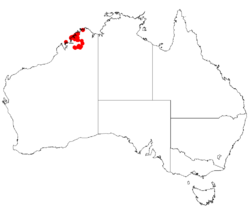Biology:Acacia adenogonia
| Acacia adenogonia | |
|---|---|
| Scientific classification | |
| Kingdom: | Plantae |
| Clade: | Tracheophytes |
| Clade: | Angiosperms |
| Clade: | Eudicots |
| Clade: | Rosids |
| Order: | Fabales |
| Family: | Fabaceae |
| Subfamily: | Caesalpinioideae |
| Clade: | Mimosoid clade |
| Genus: | Acacia |
| Species: | A. adenogonia
|
| Binomial name | |
| Acacia adenogonia (Pedley) R.S.Cowan & Maslin
| |

| |
| Occurrence data from AVH | |
Acacia adenogonia is a shrub of the genus Acacia and the subgenus Plurinerves that is endemic to north western Australia .
Description
The prickly shrub typically grows to a height of 1 to 02.5 metres (3 to 8 ft)[1] and can have an erect or sprawling habit. It has hairy and terete branchlets with persistent stipules that are up to 6.5 mm (0.26 in) in length. Like most species of Acacia it has phyllodes rather than true leaves. The evergreen, sessile to subsessile phyllodes can be patent to inclined with an inequilaterally ovate to lanceolate shape. The hairy and coriaceous phyllodes have a length of 5 to 10 m (16 to 33 ft) and a width of 1.5 to 4.5 mm (0.059 to 0.177 in) and taper to a pungent point and have three to four distant nerves.[2] It blooms from May to August and produces yellow flowers.[1]
Taxonomy
It was first described as Racosperma adenogonium by Leslie Pedley in 1987 and then described by the Richard Sumner Cowan and Bruce Maslin as Acacia adenogonia in 1990 as part of the work Acacia Miscellany. Species related to A. deltoidea (Leguminosae: Mimosoideae: Section Plurinerves) from Western Australia as published in the journal Nuytsia.[3]
Distribution
It is native to an area in the Kimberley region of Western Australia.[1] The shrub has a scattered distribution with separate populations found through the West Kimberley particularly along the Bonaparte Archipelago, the Broome and Napiere Bay areas and inland as far as Phillips Range, Kimberley Downs Station and Beverley Springs Station where it is found on areas of sandstone growing in sandy soils as a part of open woodland communities.[2]
See also
References
- ↑ Jump up to: 1.0 1.1 1.2 "Acacia adenogonia". FloraBase. Western Australian Government Department of Parks and Wildlife. https://florabase.dpaw.wa.gov.au/browse/profile/12246.
- ↑ Jump up to: 2.0 2.1 "Acacia adenogonia". World Wide Wattle. Western Australian Herbarium. http://worldwidewattle.com/speciesgallery/adenogonia.php. Retrieved 20 September 2020.
- ↑ "Acacia adenogonia (Pedley) R.S.Cowan & Maslin". Atlas of Living Australia. Global Biodiversity Information Facility. https://bie.ala.org.au/species/https://id.biodiversity.org.au/node/apni/2909041#names. Retrieved 20 September 2020.
Wikidata ☰ Q9561872 entry
 |

